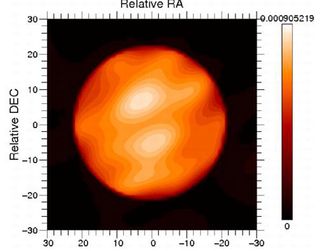Spots Like the Sun's Revealed on Giant Star

A snapshottaken of a giant star hundreds of light-years from Earth has revealed twoenormous bright spots - the first direct evidence of sun-like heattransportation on another star, scientists say.
The newinfrared view shows the behemoth star Betelgeusewith two bright blotches near its center. The bright spots are hotter than thesurrounding area, indicating regions of convection where heat rises from theinterior of the star to its surface, just like on the sun.
Theconvection may play a role in Betelgeuse's known and prolific weightloss, researchers said. The star is shedding the equivalent of one sun'sworth of mass every 10,000 to 100,000 years. It is also expelling a giganticplume of hot gas that may be related to the convection, researchers said.
Betelgeuseis a red supergiant star 600 light-years away and easy to spot in the nightsky. It forms the right shoulder of the "hunter" in the constellationOrion. The star is enormous, about 600 times the size of the sun and 20 timesas massive.
?Thesituation on Betelgeuse seems pretty much different than in the case of thesun,? said astronomer Guy Perrin, a co-leader of the research team at the ParisObservatory. ?The convective cells are far much larger.?
The brightspots, like the star itself, are also vast, with the larger of the two spanningof more than 139 million miles ? 1 1/2 times the distance between the Earth andour sun, researchers said. This larger spot is about one-quarter the star'sdiameter, they added. Similar spots on the sun are about one-twentieth thewidth of the star.
Aninternational team of astronomers led by Paris Observatory astronomer XavierHaubois and Perrin observed the Betelgeuse bright spots using three telescopes in Arizonaand a method called interferometry ? which combines observations from differenttelescopes into a cohesive whole to provide greater sensitivity. The spots,researchers said, indicate that in supergiants there is active convection,which is the process of heat moving through matter currents.
Get the Space.com Newsletter
Breaking space news, the latest updates on rocket launches, skywatching events and more!
?The starhas a patchy surface produced by a few convective cells,? Perrin told SPACE.comin an e-mail. ?Now we need to better understand the physical properties ofthese cells to go further: their temperature, their lifetime, their connectionto magnetic fields, etcetera.?
Convectionis the process that brings bubbles to the surface of boiling water in yourkitchen.
On the sun,bright convection hotspots and darker lulls (cooler areas) can easily beobserved from Earth and are well-known. But that's not the case with supergiantstars like Betelgeuse, where the size, longevity and dynamics of convectionstructures remain a mystery.
The surfaceof Betelgeuse is typically about 3,600 Kelvin (6,020 degrees Fahrenheit), with thebright spots burning about 500 degrees Kelvin (440 degrees F) hotter,researchers said. The surfaceof the sun, for comparison, is about 5,810 degrees Kelvin (10,000 degreesF).
Researchersplan to study other layers of Betelgeuse to better understand the interactionbetween its surface, atmosphere and interior, as well as how they compare toother supergiant stars.
?Betelgeusemay not be an isolated case and is not necessarily peculiar with respect toother stars of the same class,? Perrin said. ?So we may anticipate similarcells on other red supergiants.?
Theresearch, announced Tuesday, is detailed in an October 2009 edition of thejournal Astronomy & Astrophysics.
- The10 Brightest Stars
- Images:Sun Storms
- The Strangest Things inSpace
Join our Space Forums to keep talking space on the latest missions, night sky and more! And if you have a news tip, correction or comment, let us know at: community@space.com.

Tariq is the Editor-in-Chief of Space.com and joined the team in 2001, first as an intern and staff writer, and later as an editor. He covers human spaceflight, exploration and space science, as well as skywatching and entertainment. He became Space.com's Managing Editor in 2009 and Editor-in-Chief in 2019. Before joining Space.com, Tariq was a staff reporter for The Los Angeles Times covering education and city beats in La Habra, Fullerton and Huntington Beach. In October 2022, Tariq received the Harry Kolcum Award for excellence in space reporting from the National Space Club Florida Committee. He is also an Eagle Scout (yes, he has the Space Exploration merit badge) and went to Space Camp four times as a kid and a fifth time as an adult. He has journalism degrees from the University of Southern California and New York University. You can find Tariq at Space.com and as the co-host to the This Week In Space podcast with space historian Rod Pyle on the TWiT network. To see his latest project, you can follow Tariq on Twitter @tariqjmalik.
